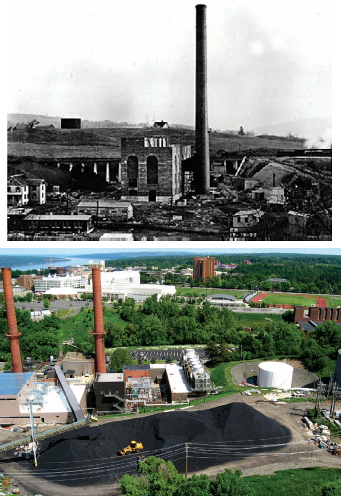![]() With the end of coal consumption on campus, Cornell's venerable Boiler Eight goes dark
With the end of coal consumption on campus, Cornell's venerable Boiler Eight goes dark
With the end of coal consumption on campus, Cornell's venerable Boiler Eight goes dark
If the Dragon Day beast were real, here's where it would have lived.
In a Twenties-era brick building at the edge of campus stood a massive iron box full of fire. You could view its interior through narrow windows, though you couldn't gaze directly at the flames without damaging your eyes; you had to use a visor that turned the roiling blaze unearthly green. Open a small door that looks like something Hansel and Gretel would have pushed the witch through, and the heat—more than 2,600 degrees Fahrenheit of coal-powered inferno—was positively breathtaking.

In late March, after burning for the better part of six and a half decades, the fire finally went out for good; as part of Cornell's commitment to generate zero net greenhouse gas emissions by 2050, the University stopped using coal. The last lumps from the University's coal pile—once measuring an acre, reaching as high as thirty feet, and comprising 15,000 tons—were shoveled onto a conveyor belt for delivery into Boiler Eight, a venerable workhorse that has heated the campus off and on since 1946. "It's an impressive piece of old machinery," says Bert Bland '74, MBA '96, senior director of the Department of Energy and Sustainability. "It's built like a battleship."
Rodney Hulbert was the third generation in his family to work the Cornell coal pile; his grandfather died there, collapsing of a heart attack while working the steam-powered crane with his son, Hulbert's father. Clad in denim overalls as he leaves the plant on the fire's final day, Hulbert admits that though he'll miss the work, it was, literally, a dirty job. "My hands are stained," he says, proffering blackened palms, "and I just washed them."
Cornell's relationship with coal goes back to the University's founding, when students burned the fuel in stoves to warm their rooms. For decades it was hauled to campus by train, but when oil prices were low in the Sixties and early Seventies, coal went out of vogue. Then the oil embargo struck, prices skyrocketed, and the University fired up Boiler Eight again—though, since nearby railway bridges had been destroyed in a 1972 hurricane, the coal had to be trucked in. Number Eight soldiered on, more or less the same, for decades. But its fate was sealed in December 2009, when the University opened its highly efficient Combined Heat and Power Plant. Located in a new building adjacent to the 1922 facility, it features two giant gas-fired turbines that generate electricity, with waste heat captured to make steam that warms the campus.
While the workers who tended Boiler Eight seem disinclined to sentimentality, at least one—senior plant operator Dave VanDeMark, a thirty-four-year veteran—plans on snagging a keepsake when he retires, one of the thousands of iron "fingers" that fed the coal into the fire. And though that blaze has gone out for good (time of death: approximately 11 p.m. on Wednesday, March 23), Bland hopes to breathe new life into the boiler by someday converting it to solid biomass. "It kept the campus warm more than once when everything else went down," VanDeMark says. "It was an effort to keep it running, but I'm sorry to see it go."
{movremote}http://www.news.cornell.edu/stories/March11/Moving.beyond.coal.mov{/movremote}
The last bucket of coal


